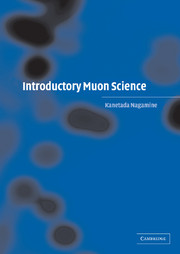Book contents
- Frontmatter
- Contents
- Preface
- List of abbreviations
- 1 What are muons? What is muon science?
- 2 Muon sources
- 3 Muons inside condensed matter
- 4 The muonic atom and its formation in matter
- 5 Muon catalyzed fusion
- 6 Muon spin rotation/relaxation/resonance: basic principles
- 7 Muon spin rotation/relaxation/resonance: probing microscopic magnetic properties
- 8 Muon spin rotation/relaxation/resonance: probing induced microscopic systems in condensed matter
- 9 Cosmic-ray muon probe for internal structure of geophysical-scale materials
- 10 Future trends in muon science
- Further reading
- Index
- References
6 - Muon spin rotation/relaxation/resonance: basic principles
Published online by Cambridge University Press: 22 October 2009
- Frontmatter
- Contents
- Preface
- List of abbreviations
- 1 What are muons? What is muon science?
- 2 Muon sources
- 3 Muons inside condensed matter
- 4 The muonic atom and its formation in matter
- 5 Muon catalyzed fusion
- 6 Muon spin rotation/relaxation/resonance: basic principles
- 7 Muon spin rotation/relaxation/resonance: probing microscopic magnetic properties
- 8 Muon spin rotation/relaxation/resonance: probing induced microscopic systems in condensed matter
- 9 Cosmic-ray muon probe for internal structure of geophysical-scale materials
- 10 Future trends in muon science
- Further reading
- Index
- References
Summary
The principle of the muon spin rotation/relaxation/resonance (μSR) method is based upon the laws of particle physics. As seen in Figure 1.5, the spin of the μ+(μ−), when it is born via the decay of the π+(π−, is completely polarized along the direction of its motion; once the μ+(μ−) are focused or collimated along one direction, the resulting beam is polarized along its direction of motion. During the slowing-down of the μ+(μ− inside the host material, as described in Chapter, the spin polarization is maintained in the long-lived form of diamagnetic μ+, paramagnetic Mu (ortho state with spin = 1), or ground state of a muonic atom in the case of μ−. After stopping at some specific microscopic location, the μ+(μ−) decays into e+(e−) and two neutrinos, as shown in Figure 1.5, with the e+ (e−) spatial distribution oriented preferentially along the μ+(μ−) spin direction. The decay e+(e−) energy ranges up to 50 MeV, and the direction of the μ+(μ−) spin can be observed in a time-resolved fashion by measuring these high-energy e+(e−) using detectors placed outside the target material to be investigated; measurements are carried out under variations of external conditions such as temperature, pressure, and applied magnetic or electric fields.
The μSR method can be considered as a sensitive magnetic “compass” to probe the microscopic magnetic properties of condensed matter.
Information
- Type
- Chapter
- Information
- Introductory Muon Science , pp. 100 - 125Publisher: Cambridge University PressPrint publication year: 2003
